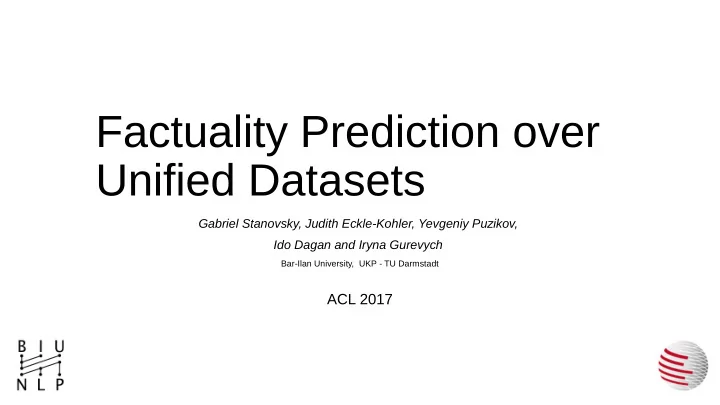

Factuality Prediction over Unified Datasets Gabriel Stanovsky, Judith Eckle-Kohler, Yevgeniy Puzikov, Ido Dagan and Iryna Gurevych Bar-Ilan University, UKP - TU Darmstadt ACL 2017
Factuality Task Definition Author’s commitment towards a proposition • Factual • It is not surprising that the Cavaliers lost the championship • Uncertain • She still has to check whether the experiment succeeded • Counter-factual • Don was dishonest when he said he paid his taxes • Useful for • Knowledge base population • Question answering • Recognizing textual entailment
In this talk • Problem: Limited Generality • Previous work focused on specific flavors of factuality • Approach • Build a unified dataset • Train a new model • Contributions • Normalized annotations • Large aggregated corpus • Improving performance across datasets
Problem: Limited Generality
Datasets • Many annotation efforts • FactBank (Saur´ı and Pustejovsky, 2009) • UW (Lee et al., 2015) • Meantime (Minard et al., 2016) • … and more • Datasets differ in various aspects • Discrete vs. continuous values • Expert vs. crowdsourced annotation • Point of view
Annotated Examples FactBank vs. UW FactBank CT- CT+ Officials have been careful not to draw any firm conclusions -1.2 Doesn’t annotate adjectival predicates Continuous scale [-3, +3] UW
Annotated Examples FactBank vs. UW FactBank 8 discrete values Doesn’t annotate hypotheticals CT+ CT- Kavan said the Czech would no longer become “the powerless victim of an invasion.” 3.0 -0.6 3.0 Doesn’t annotate adjectival predicates Continuous scale [-3, +3] UW
Previous Work: Factuality Prediction • Models were designed and evaluated on specific datasets • For example, Lee et al. (2015): • Used SVM on syntactic features • lemma, POS, dependency paths • Tested on the UW corpus Non-comparable results Limited portability
Solution: Unified Corpus Extending TruthTeller Evaluation
Simple Normalization • Mapping discrete values to the continuous UW scale • Simple mapping based on overlapping annotations
Unified Factuality Corpus
Biased Distribution • Corpus skewed towards factual • Inherent trait of the news domain?
Solution: Unified Corpus Model : Extending TruthTeller Evaluation
TruthTeller (Lotan et al., 2013) • Rule based approach on dependency trees • Karttunen implicative signatures • Syntactic cues (modality, negation, etc.) • Hand-written lexicon of 1,700 predicates
Extending TruthTeller • Semi automatic extension of lexicon by 40% • Translated from German verb classes (Eckle-Kohler, ACL 2016) • Supervised learning: TruthTeller as signal • Application of implicative signatures on PropS
Solution: Unified Corpus Extending TruthTeller Evaluation
Metrics (lee et al., 2015) 1. Mean Absolute Error • Range: [0, 6] • Smaller is better! 2. Pearson Correlation • How good is a system in recovering the variation • Well-suited for the biased news domain
Evaluations
Evaluations Marking all propositions as factual Is a strong baseline on this dataset
Evaluations Dependency features correlate well
Evaluations Applying implicative signatures on AMR did not work well
Evaluations Hard coded rules aren't robust Enough across datasets
Evaluations Our extension of TruthTeller gets good results across all datasets
Conclusions and Future Work • Resources made publicly available • Unified Factuality corpus • Conversion code and trained models • Future work • Annotate diverse domains • Integrate TruthTeller with more lexical-syntactic feats. • Try our online demo: http://u.cs.biu.ac.il/~stanovg/factuality.html Thanks for listening!
Recommend
More recommend